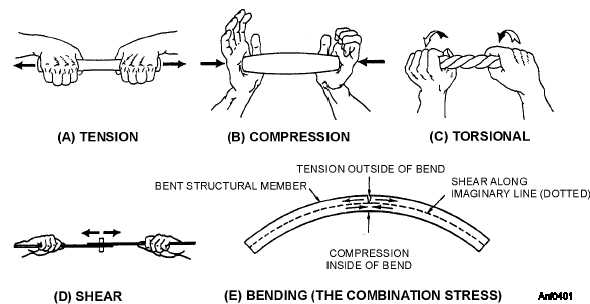SHEAR
Cutting a piece of paper with scissors is an example
of a shearing action. In an aircraft structure, shear (fig.
4-1, view D) is a stress exerted when two pieces of
fastened material tend to separate. Shear stress is the
outcome of sliding one part over the other in opposite
directions. The rivets and bolts of an aircraft experience
both shear and tension stresses.
BENDING
Bending (fig. 4-1, view E) is a combination of
tension and compression. For example, when bending a
piece of tubing, the upper portion stretches (tension)
and the lower portion crushes together (compression).
The wing spars of an aircraft in flight are subject to
bending stresses.
TORSION
Torsional (fig. 4-1, view C) stresses result from a
twisting force. When you wring out a chamois skin, you
are putting it under torsion. Torsion is produced in an
engine crankshaft while the engine is running. Forces
that produce torsional stress also produce torque.
VARYING STRESS
All structural members of an aircraft are subject to
one or more stresses. Sometimes a structural member
has alternate stresses; for example, it is under
compression one instant and under tension the next.
The strength of aircraft materials must be great enough
to withstand maximum force of varying stresses.
SPECIFIC ACTION OF STRESSES
You need to understand the stresses encountered on
the main parts of an aircraft. A knowledge of the basic
stresses on aircraft structures will help you understand
why aircraft are built the way they are. The fuselage of
an aircraft is subject the fives types of stress—torsion,
bending, tension, shear, and compression.
Torsional stress in a fuselage is created in several
ways. For example, torsional stress is encountered in
engine torque on turboprop aircraft. Engine torque
tends to rotate the aircraft in the direction opposite to
the direction the propeller is turning. This force creates
a torsional stress in the fuselage. Figure 4-2 shows the
effect of the rotating propellers. Also, torsional stress
on the fuselage is created by the action of the ailerons
when the aircraft is maneuvered.
When an aircraft is on the ground, there is a
bending force on the fuselage. This force occurs
because of the weight of the aircraft. Bending increases
when the aircraft makes a carrier landing. This bending
action creates a tension stress on the lower skin of the
fuselage and a compression stress on the top skin.
Bending action is shown in figure 4-3. These stresses
are transmitted to the fuselage when the aircraft is in
flight. Bending occurs because of the reaction of the
airflow against the wings and empennage. When the
4-2
Figure 4-1.—Five stresses acting on an aircraft.



